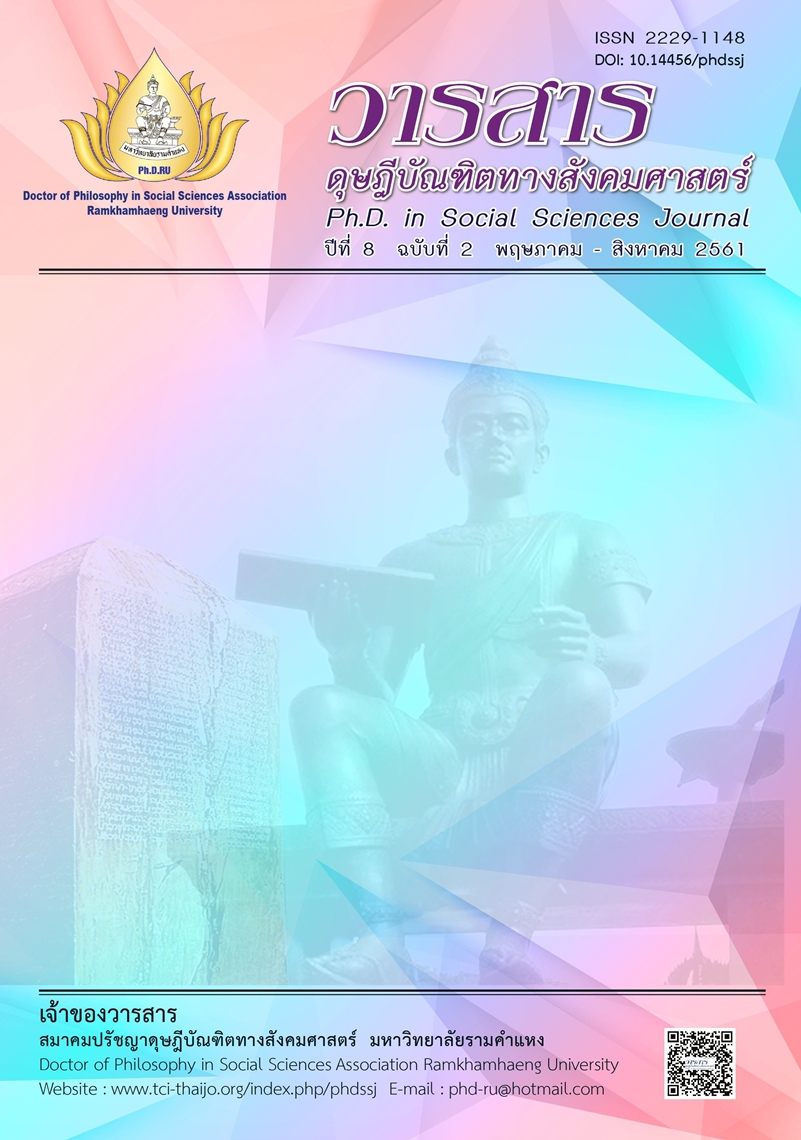BUILDING EMPLOYEE ENGAGEMENT: A CASE STUDY OF AUTOMOBILE ASSEMBLY PLANT IN THAILAND
Main Article Content
Abstract
This research aims to study how to build employee engagement and to study the factors that are important for employee engagement in Thai automobile assembly plants. This is a Mixed Method Research. For qualitative research, in-depth interviews of 40 employees from Thai automobile assembly plants were conducted by using Robert Yin’s guideline (Yin, 2003). For quantitative research, questionnaires were used to collect the data from 384 employees from Thai automobile assembly plants. Descriptive statistics were employed to analyze the data, including frequency, percentage, mean, and standard deviation.
The results showed that the opinions of each level of employees towards how to create employee engagement for organizations are different. The creation of new employee engagement focuses on the human resources management process, from the planning process to the employee retention process. For the current working group, they focuses on creating organizational cultures, make employees talent, encourage team to participant, team work, and motivation. From supervisor’s point of view, to create the employee engagement, the organization has to understand the employees’ needs, to pay attention to their employees, and to support their employees if they required. For the employees’ opinion, teamwork, supervisor, career and opportunities development, compensation and brand loyalty are the major cause of employee engagement. This study also found that factors that are important for employee engagement in Thai automobile assembly plants includes monetary and non-monetary compensation factors, working environment factors, security and opportunities for career advancement in the organization factors, employee/ co-worker factors, and supervisor factors.
Article Details
Academic articles, research articles, and book reviews in the Ph.D. in Social Sciences Journal are author’s opinions, and not the publisher’s, and is not the responsibility of the Ph.D. in Social Sciences Journal Philosophy Association, Ramkhamhaeng University. (In the case that research is done on human, the researcher has to be trained in Ethics for Doing Research on Human Training and has to produce the evidence of the training).
References
Baron, R. M., & Kenny, D. A. (1986). The moderator-mediator variable distinction in social psychological research: Conceptual, strategic, and statistical considerations. Journal of Personality and Social Psychology, 51(6), 1173-1182.
Business Law and Human Resources. (2012). Employee engagement. Variety, 10(109), 96-97.
Charakunphruek, S. (2008). Factors affecting on organizational commitment of flight attendant (women only) of Nok Airline Co., Ltd. Master's thesis educational psychology, Srinakharinwirot University. [In Thai]
Dunham, R. B., Grube, J. A., & Castaneda, M. B. (1994). Organizational commitment: The utility of an integrative definition. Journal of Applied Psychology, 79(3), 370-380.
Delaney, J. T., & Huselid, M. A. (1996). The impact of human resource management practices on performance in for-profit and nonprofit organizations. Academy of Management Journal, 39(4), 949-969.
Devanna, M. A., Fombrun, C. J., & Tichy, N. M. (1984). A framework for strategic human resource management, in Forum. New York: John Wiley & Sons.
Gallup Organization. (2014). Gallup’s research-based approach. Retrieved December 31, 2017, from https://www.gallup.com/poll/188144/employee-engagement-stagnant-2015.aspx
Gibson, J. L., Ivancevich, J. M., & Dennelly, J. H. (1997). Organizations: Behavior, structure, process (9th ed.). New York: McGraw-Hill.
Guest, D. E. (1997). Human resource management and performance: A review and research agenda. The International Journal of Human Resource Management, 8(3), 263-276.
Harter, J. K., Schmidt, F. L., & Hayes, T. L. (2002). Business unit-level relationship between employee satisfaction, employee engagement, and business outcomes: A meta-analysis. Journal of Applied Psychology, 87(2), 268-279.
Hay Group. (2005). The innovative organization: Lessons learned from mostadmired companies. Retrieved December 31, 2017, from http://www.haygroup.com/downloads/es/Hay_Insight_Selections_April_2005.pdf
Hewitt Associates. (2004). Employee engagement higher at double-digit growth companies. Retrieved December 31, 2017, from http://www.hewittassociates.com/Intl/NA/en-US/Default.aspx
Huselid, M. A. (1995). The impact of human resource management practices on turnover, productivity, and corporate financial performance. Academy of Management Journal, 38(3), 635-672.
Ivancevich, J. M., & Matteson, M. T. (1999). Organizational behavior and management (5th ed.). Singapore: McGraw-Hill.
Krejcie, R. V., & Morgan, D. W. (1970). Determining sample size for research activities. Educational and Psychological Measurement, 30(3), 607-610.
Laksong, T. (2014). Orgamozational commitment among employees working for an automotive parts company in Amata Nakorn Industrial Estate, Chonburi province. Chonburi: Burapha University. [In Thai]
Mercer. (2007). Engaging employees to drive global business success: Insights from mercer’s what’s working™ research.
Ministry of Industry. (2011). National industrial development master plan, 2012-2031. Bangkok. Author. [In Thai]
Organisation Internationale des Constructeurs d’Automobiles. (2014). World motor vehicle production. Retrieved December 31, 2017,from https://www.oica.net/category/production-statistics
Panya, P. (2015). Engagement of employees in ceramics industrial factories in Lampang. Journal of Modern Management Science, 8(1), 17-29. [In Thai]
Perrin, T. (2008). Closing the engagement gap: A road map for driving superior business performance. Towers Perrin Global Workforce Study 2007-2008.
Patton, M.Q. (2001). Qualitative research and evaluation methods (2nd ed.). Thousand oaks, CA: Sage.
Prakobsuk, A. (2006). The organization commitment: A case study of Siam Nissan Automobile Company Limited. Bangkok: National Institute of Development Administration. [In Thai]
Stum, D. L. (1999). Maslow revisited: Building the employee commitment pyramid. Strategy and Leadership, 29(4), 4-9.
Thailand Automotive Institute. (2015). Thailand automotive industry overview 2015. (Jan-Dec). Bangkok: Author. [In Thai]
Tsai, C.-H., Chen, S.-J., & Fang, S.-C. (2009). Employment modes, high performance work systems, and organizational performance in hospitality industry. Cornell Hospitality Quarterly, 50(4), 413-431.
Towers, W. (2010). Employee engagement: Improving engagement to improve results. Retrieved December 31, 2017, from https://www.towersperrin.com/tp/showhtml.isp?url=global/service-areas/research-and-surveys/employee-research/ee-engagement.htm
Tussananakajit, P. (2007). Factors related to self-development of irrigation office officers 11. Master's independent study arts (political science), Kasetsart University. [In Thai]
Yin, R. K. (2003). Case study research: Design and methods (3rd ed.). Newbury Park, CA: Sage.
Youndt, M. A., Snell, S .A., Dean, J. E., & Lepak, D. P. (1996). Human resource management, manufacturing strategy, and firm performance. Academy of Management Journal, 39(4), 836-866.
Yodwisitsak, K. (2013). Enhancing employee satisfaction and engagement in 2013: Metropolitan electricity authority. Bangkok: Thammasat University, Research and Consultancy Institute. [In Thai]
Zheng, C., Morrison, M., & O’Neill, G. (2006). An empirical study of high performance HRM practices
in Chinese SMEs. International Journal of Human Resource Management, 17(10), 1772-1803.


